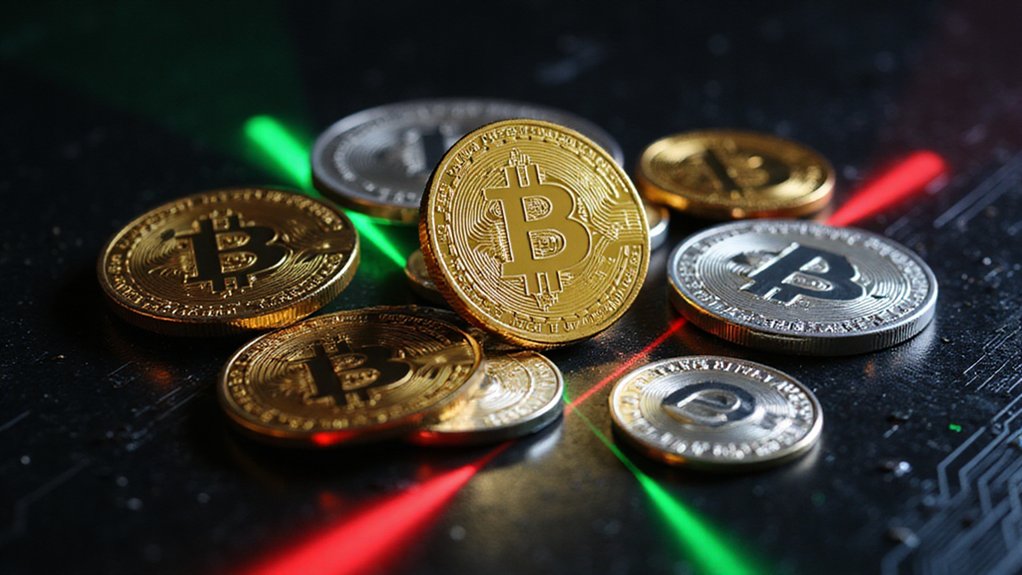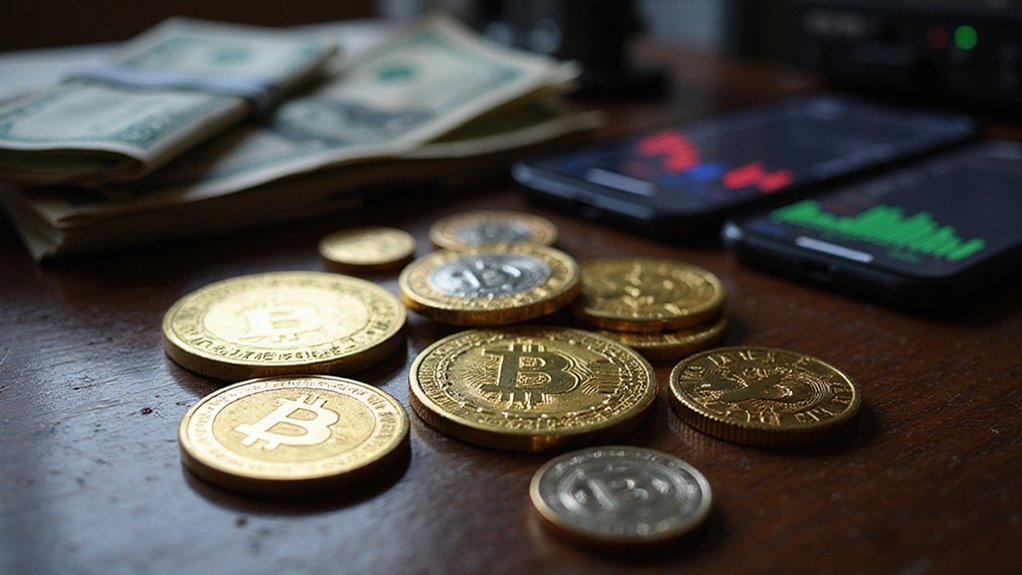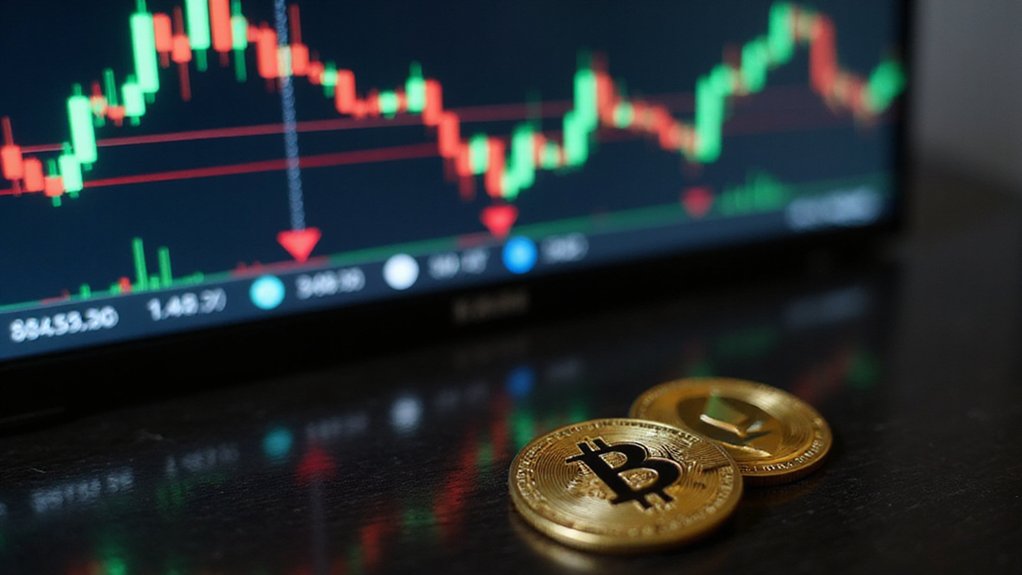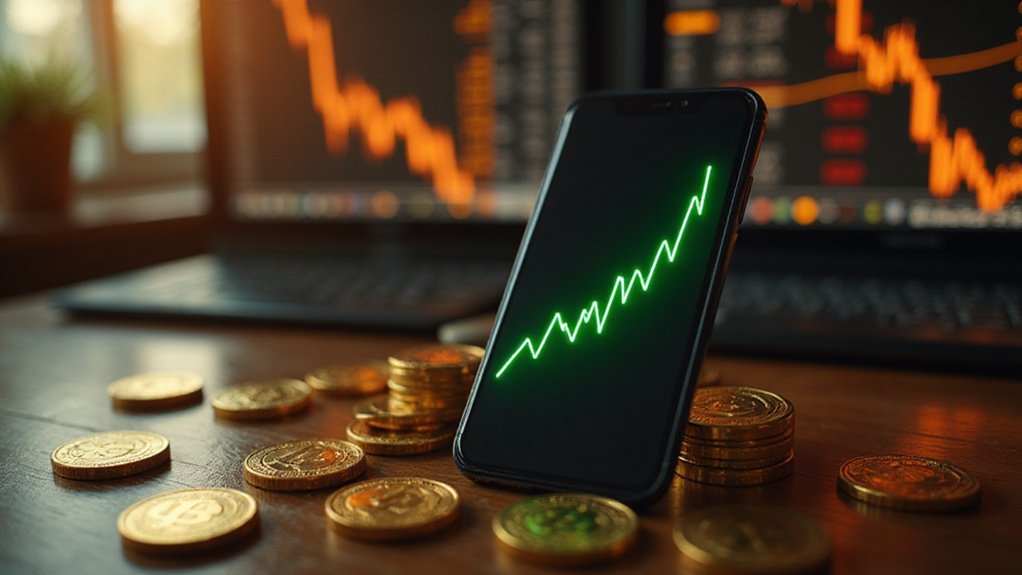The cryptocurrency market oscillates between speculative euphoria and institutional pragmatism, with projections reaching $5 billion by 2030 amid a $2.66 trillion current valuation. Stablecoins emerge as the practical bridge between volatile digital assets and traditional finance, while regulatory frameworks simultaneously threaten innovation and enhance legitimacy. DeFi platforms revolutionize financial services as AI tokens surge from $2.7 billion to $39 billion, though environmental concerns temper enthusiasm. Further examination reveals the nuanced forces shaping this evolving landscape.

How does one reconcile a market that oscillates between euphoric speculation and grudging institutional acceptance while simultaneously grappling with existential questions about energy consumption and regulatory legitimacy?
The cryptocurrency landscape presents exactly this paradox, with projections suggesting the global market will balloon from $2.1 billion to $5 billion by 2030—though one suspects these figures pale beside the $2.66 trillion market cap recently achieved, threatening to eclipse 2021’s historic peaks.
Bitcoin maximalists harbor dreams of $123,000 valuations by 2025’s close, a prediction that would likely amuse traditional finance veterans who’ve witnessed countless such proclamations.
Yet beneath this speculative fervor lies genuine institutional momentum, driven largely by stablecoins’ expanding utility across cross-border transactions and payment systems.
Stablecoins emerge as cryptocurrency’s pragmatic foundation, bridging speculative markets with institutional necessity through cross-border payment infrastructure.
These digital anchors provide the stability that volatile cryptocurrencies inherently lack, facilitating mainstream adoption across industries previously skeptical of blockchain technology.
Regulatory frameworks emerge as the market’s primary catalyst—or executioner, depending on implementation.
Increased oversight promises enhanced trust through improved security measures and anti-fraud standards, potentially accelerating institutional adoption.
However, compliance requirements could simultaneously stifle innovation and introduce volatility that regulatory bodies ostensibly seek to eliminate.
Decentralized finance platforms continue revolutionizing traditional financial services while tokenization transforms illiquid assets—real estate, art, collectibles—into fractional ownership opportunities.
This democratization of previously exclusive markets represents DeFi’s most compelling proposition, expanding access to broader audiences while improving liquidity for traditionally static investments.
Artificial intelligence increasingly drives market efficiencies, enhancing trading algorithms, security protocols, and fraud detection mechanisms.
These technological advances suggest a future where sophisticated AI-driven strategies could fundamentally alter market dynamics and prediction accuracy. The AI token sector exemplifies this convergence, with nearly 90 AI tokens now operating across blockchain protocols and decentralized platforms, their collective market value soaring from $2.7 billion to over $39 billion.
Environmental concerns remain the sector’s most persistent existential threat.
Mining operations’ energy consumption faces mounting regulatory scrutiny, forcing the industry toward sustainable practices and green technologies.
The tension between innovation and environmental responsibility will likely determine cryptocurrency’s long-term viability. Layer-2 solutions like Lightning Network and Polygon are emerging to address these scalability challenges while reducing environmental impact.
Market sentiment remains remarkably optimistic—92% of U.S. holders express confidence in blockchain’s economic potential, while 55% monitor crypto markets more diligently than traditional ones.
Such enthusiasm, whether rational or misguided, continues fueling adoption despite legitimate concerns about sustainability and regulatory uncertainty. The emergence of altcoin season brings heightened focus to non-Bitcoin cryptocurrencies, with investors increasingly shifting capital toward diverse blockchain projects that demonstrate innovative technologies and substantial growth potential.
Frequently Asked Questions
How Do Government Regulations Affect Cryptocurrency Prices and Market Volatility?
Government regulations create a fascinating paradox in cryptocurrency markets—the more extensive the regulatory framework, the more efficient (and ironically, less volatile) these ostensibly “decentralized” assets become.
Clear regulatory guidance typically boosts investor confidence while reducing price swings, though regulatory uncertainty can trigger dramatic fluctuations.
Different regulatory approaches—whether treating cryptocurrencies as securities, commodities, or developing specific stablecoin frameworks—create distinct market dynamics that traders must navigate with considerable finesse.
What Are the Tax Implications of Buying and Selling Cryptocurrencies?
Cryptocurrency transactions trigger capital gains obligations upon disposal—selling, trading, or spending digital assets.
Short-term gains (assets held under one year) face ordinary income rates up to 37%, while long-term holdings enjoy preferential rates of 0%, 15%, or 20%.
Purchasing crypto itself creates no immediate tax liability, though meticulous record-keeping becomes essential for future compliance.
The IRS treats these digital assets as property, not currency—a distinction carrying significant reporting requirements.
Which Cryptocurrency Exchanges Are Most Secure for Trading and Storing Assets?
Coinbase, Kraken, and Gemini emerge as the triumvirate of secure exchanges, each wielding institutional-grade cold storage and regulatory compliance like digital fortresses.
Coinbase offers publicly-traded transparency (alongside user-friendly interfaces that somehow make crypto trading feel almost respectable), while Gemini provides SOC 2 compliance and asset insurance.
Kraken emphasizes operational transparency—a welcome concept in crypto’s often opaque landscape.
Binance, despite its robust ecosystem, faces regulatory headwinds across multiple jurisdictions.
How Can Beginners Start Investing in Cryptocurrency With Minimal Risk?
Beginners should start with established cryptocurrencies like Bitcoin or Ethereum on reputable exchanges, investing only disposable income—because apparently losing sleep over digital assets has become a rite of passage.
Hardware wallets provide essential security (though one might question storing imaginary money in physical devices).
Dollar-cost averaging minimizes timing risks, while diversification across multiple established coins reduces exposure.
Most importantly, resist the urge to check prices hourly—sanity preservation remains undervalued.
What Role Do Institutional Investors Play in Cryptocurrency Market Movements?
Institutional investors wield considerable influence over cryptocurrency markets, with over three-quarters planning increased allocations in 2025—some dedicating more than 5% of assets under management to digital currencies.
Their participation transforms market dynamics through enhanced liquidity, reduced volatility, and legitimized adoption.
The introduction of Bitcoin and Ethereum ETPs exemplifies this institutional embrace, creating price momentum that individual retail investors could never generate alone, fundamentally reshaping crypto’s traditional boom-bust cycles.









